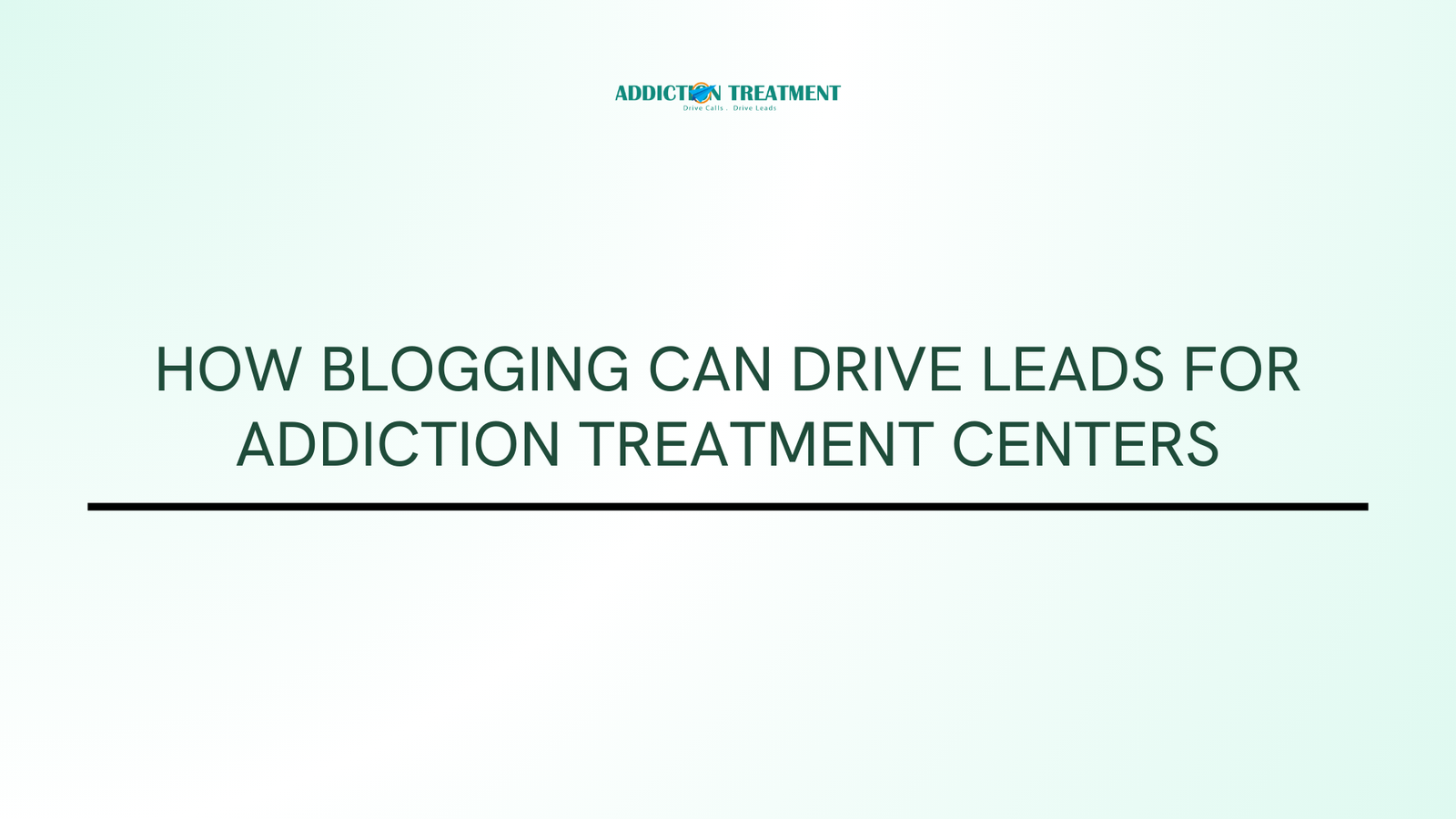Blogging has become an essential component of digital marketing for addiction treatment centers. A well-executed blog strategy can increase online visibility, educate potential clients, and establish trust with individuals and families seeking help. By addressing common questions, sharing expertise, and optimizing content for search engines, blogs can effectively generate qualified leads and build lasting relationships with your audience.
This article explores the role of blogging in driving leads for addiction treatment centers, actionable tips for creating impactful blog content, and strategies for optimizing your efforts to attract and convert potential clients.
Why Blogging Matters for Addiction Treatment Centers
1. Boosts Search Engine Visibility
Blogs optimized for search engines (SEO) help your website rank higher in search results, making it easier for potential clients to find your services.
- Target Long-Tail Keywords: Phrases like “how to choose the best rehab center” or “signs of addiction in loved ones” often have lower competition and attract users with specific needs.
2. Educates and Engages Your Audience
Blog content provides valuable information about addiction, treatment options, and recovery, empowering readers to make informed decisions.
- Builds Trust: Offering actionable advice positions your center as a knowledgeable and compassionate resource.
- Encourages Interaction: Blogs can invite readers to comment, share, or contact your center for more information.
3. Drives Traffic to Your Website
Consistently publishing relevant and engaging content increases website traffic, which can lead to more inquiries and conversions.
- Internal Linking: Blogs can guide readers to key service pages, such as inpatient treatment or detox programs.
- Lead Magnets: Offer downloadable guides or resources in exchange for contact information.
Types of Blog Content That Drive Leads
1. Educational Content
Educational blogs answer common questions about addiction and recovery, addressing the pain points of potential clients.
- Example Topics:
- “How Does Detox Work in Rehab?”
- “What Are the Benefits of Inpatient Treatment?”
- “How to Support a Loved One in Recovery.”
2. Success Stories
Sharing real-life stories of recovery inspires hope and demonstrates the effectiveness of your treatment programs.
- Format: Highlight a patient’s journey (with permission) or anonymized case studies that show positive outcomes.
3. Frequently Asked Questions (FAQs)
Blogs that address frequently asked questions provide quick answers and establish your center as a helpful resource.
- Example Topics:
- “What Types of Insurance Cover Rehab Services?”
- “What Is the Average Length of Stay in Rehab?”
4. Industry News and Trends
Position your center as a thought leader by sharing insights into the latest trends and developments in addiction treatment.
- Example Topics:
- “The Rise of Telehealth in Addiction Recovery.”
- “How Legislation Affects Access to Treatment.”
5. Listicles and Guides
List-based blogs or comprehensive guides are easy to read and share.
- Example Topics:
- “10 Signs Your Loved One Needs Rehab.”
- “The Ultimate Guide to Addiction Recovery.”
How Blogging Drives Leads for Addiction Treatment Centers
1. Improves SEO Rankings
Search engine optimization is key to driving organic traffic to your website. By creating high-quality blog content that targets relevant keywords, you can rank higher in search results for terms potential clients are searching for.
- On-Page SEO Tips:
- Use keywords in headings, subheadings, and meta descriptions.
- Optimize images with alt text.
- Ensure your content is mobile-friendly.
2. Encourages Engagement and Shares
Engaging blog posts encourage readers to spend more time on your website, share your content, and refer others to your services.
- Social Media Sharing: Promote blogs on Facebook, LinkedIn, or Instagram to reach a wider audience.
- Call-to-Action (CTA): Include CTAs like “Contact us today to learn more” or “Download our free recovery guide” to drive conversions.
3. Supports the Buyer’s Journey
Blogs address different stages of the buyer’s journey, guiding readers from awareness to action.
- Awareness Stage: General educational content to attract a broad audience.
- Consideration Stage: Blogs that compare treatment options or explain the rehab process.
- Decision Stage: Success stories and testimonials that encourage readers to take the next step.
4. Generates Leads Through Lead Magnets
Blogs can include lead magnets, such as free guides or webinars, to capture contact information.
- Example Lead Magnets:
- “Download Our Free Guide to Choosing the Right Rehab Center.”
- “Sign Up for Our Webinar: Overcoming Addiction.”
Tips for Creating Effective Blog Content
1. Understand Your Audience
Identify your target audience’s needs, concerns, and preferences to create content that resonates with them.
- Audience Segments: Potential patients, family members, and referral partners (e.g., doctors or therapists).
- Common Questions: Address topics like cost, treatment types, and what to expect in rehab.
2. Focus on Empathy and Support
Addiction is a sensitive topic. Use compassionate language and avoid judgmental tones.
- Example Phrasing: “You’re not alone in this journey” instead of “Don’t let addiction ruin your life.”
3. Incorporate Visuals
Enhance your blogs with images, videos, infographics, or charts to make content more engaging and shareable.
- Example: Use an infographic to illustrate the steps of the recovery process.
4. Consistency is Key
Publish blog posts consistently to maintain engagement and improve SEO rankings.
- Frequency: Aim for at least 2–4 posts per month, depending on your resources.
- Content Calendar: Plan topics in advance to ensure a steady flow of content.
5. Promote Your Blogs
Simply publishing a blog isn’t enough; you need to actively promote it.
- Email Marketing: Share new blog posts with your email list.
- Social Media: Post snippets of your blogs on social platforms with a link to read more.
Outreach: Collaborate with industry influencers or partners to share your content.
Measuring the Success of Your Blog Strategy
To evaluate the effectiveness of your blogs, track these key metrics:
- Traffic: Monitor the number of visitors to your blog pages using tools like Google Analytics.
- Engagement: Measure time on page, bounce rates, and social shares to assess reader interest.
- Lead Generation: Track how many blog visitors convert into leads through contact forms or downloads.
SEO Performance: Use tools like SEMrush or Ahrefs to analyze keyword rankings and backlinks.
Overcoming Challenges in Blogging for Addiction Treatment Centers
1. Creating Consistent Content
Generating fresh ideas and maintaining consistency can be challenging.
Solution: Develop a content calendar and involve a team of writers or freelance professionals.
2. Balancing SEO with Quality
Focusing too heavily on SEO can make content feel unnatural or repetitive.
Solution: Write for your audience first and optimize for search engines second.
3. Maintaining Sensitivity
It’s easy to unintentionally use language that feels judgmental or insensitive. Solution: Review content with a focus on empathy and inclusivity.
Conclusion
Blogging is a powerful tool for addiction treatment centers to drive leads, educate their audience, and establish trust. By creating valuable, empathetic, and SEO-optimized content, you can attract potential clients, guide them through the decision-making process, and ultimately connect them with the help they need. With a strategic approach and consistent efforts, blogging can become a cornerstone of your digital marketing strategy.


Leave a Reply